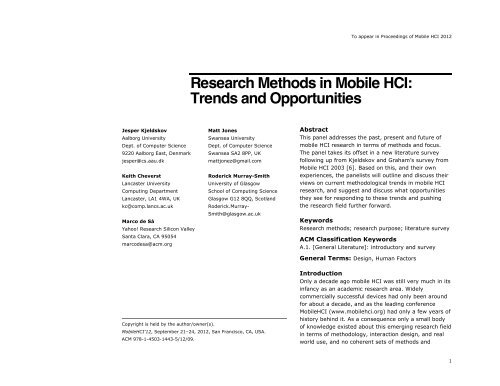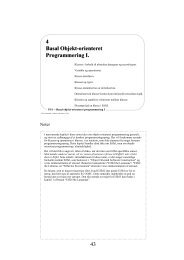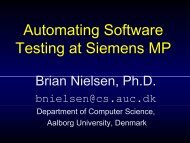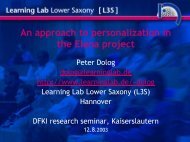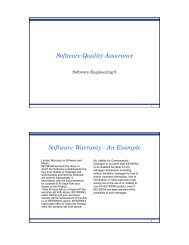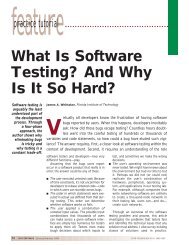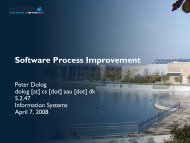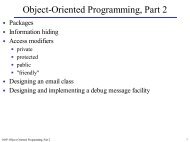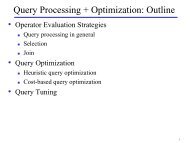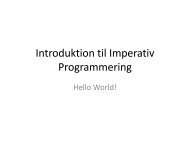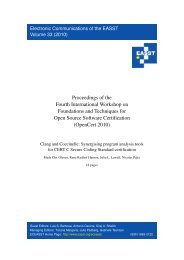Research Methods in Mobile HCI: Trends and Opportunities
Research Methods in Mobile HCI: Trends and Opportunities
Research Methods in Mobile HCI: Trends and Opportunities
You also want an ePaper? Increase the reach of your titles
YUMPU automatically turns print PDFs into web optimized ePapers that Google loves.
Jesper Kjeldskov<br />
Aalborg University<br />
Dept. of Computer Science<br />
9220 Aalborg East, Denmark<br />
jesper@cs.aau.dk<br />
Keith Cheverst<br />
Lancaster University<br />
Comput<strong>in</strong>g Department<br />
Lancaster, LA1 4WA, UK<br />
kc@comp.lancs.ac.uk<br />
Marco de Sá<br />
Yahoo! <strong>Research</strong> Silicon Valley<br />
Santa Clara, CA 95054<br />
marcodesa@acm.org<br />
Copyright is held by the author/owner(s).<br />
To appear <strong>in</strong> Proceed<strong>in</strong>gs of <strong>Mobile</strong> <strong>HCI</strong> 2012<br />
<strong>Research</strong> <strong>Methods</strong> <strong>in</strong> <strong>Mobile</strong> <strong>HCI</strong>:<br />
<strong>Trends</strong> <strong>and</strong> <strong>Opportunities</strong><br />
<strong>Mobile</strong><strong>HCI</strong>’12, September 21–24, 2012, San Francisco, CA, USA.<br />
ACM 978-1-4503-1443-5/12/09.<br />
Matt Jones<br />
Swansea University<br />
Dept. of Computer Science<br />
Swansea SA2 8PP, UK<br />
mattjonez@gmail.com<br />
Roderick Murray-Smith<br />
University of Glasgow<br />
School of Comput<strong>in</strong>g Science<br />
Glasgow G12 8QQ, Scotl<strong>and</strong><br />
Roderick.Murray-<br />
Smith@glasgow.ac.uk<br />
Abstract<br />
This panel addresses the past, present <strong>and</strong> future of<br />
mobile <strong>HCI</strong> research <strong>in</strong> terms of methods <strong>and</strong> focus.<br />
The panel takes its offset <strong>in</strong> a new literature survey<br />
follow<strong>in</strong>g up from Kjeldskov <strong>and</strong> Graham’s survey from<br />
<strong>Mobile</strong> <strong>HCI</strong> 2003 [6]. Based on this, <strong>and</strong> their own<br />
experiences, the panelists will outl<strong>in</strong>e <strong>and</strong> discuss their<br />
views on current methodological trends <strong>in</strong> mobile <strong>HCI</strong><br />
research, <strong>and</strong> suggest <strong>and</strong> discuss what opportunities<br />
they see for respond<strong>in</strong>g to these trends <strong>and</strong> push<strong>in</strong>g<br />
the research field further forward.<br />
Keywords<br />
<strong>Research</strong> methods; research purpose; literature survey<br />
ACM Classification Keywords<br />
A.1. [General Literature]: <strong>in</strong>troductory <strong>and</strong> survey<br />
General Terms: Design, Human Factors<br />
Introduction<br />
Only a decade ago mobile <strong>HCI</strong> was still very much <strong>in</strong> its<br />
<strong>in</strong>fancy as an academic research area. Widely<br />
commercially successful devices had only been around<br />
for about a decade, <strong>and</strong> as the lead<strong>in</strong>g conference<br />
<strong>Mobile</strong><strong>HCI</strong> (www.mobilehci.org) had only a few years of<br />
history beh<strong>in</strong>d it. As a consequence only a small body<br />
of knowledge existed about this emerg<strong>in</strong>g research field<br />
<strong>in</strong> terms of methodology, <strong>in</strong>teraction design, <strong>and</strong> real<br />
world use, <strong>and</strong> no coherent sets of methods <strong>and</strong><br />
1
techniques for mobile <strong>HCI</strong> had yet been established.<br />
Driven by the saturation <strong>and</strong> technological maturity of<br />
mobile devices throughout society, there was, however,<br />
a huge <strong>in</strong>terest <strong>in</strong> the new <strong>in</strong>teraction design<br />
possibilities of this fast exp<strong>and</strong><strong>in</strong>g area of comput<strong>in</strong>g. In<br />
2002 this situation motivated a comprehensive<br />
literature survey of mobile <strong>HCI</strong> research by Kjeldskov<br />
<strong>and</strong> Graham [6]. The purpose of this was to provide a<br />
snapshot of state-of-the-art <strong>and</strong> current practices, <strong>and</strong><br />
through this identify shortcom<strong>in</strong>gs <strong>and</strong> opportunities for<br />
future research directions. The literature survey was<br />
presented at <strong>Mobile</strong> <strong>HCI</strong> <strong>in</strong> Ud<strong>in</strong>e <strong>in</strong> 2003 the second<br />
time this conference ran as a full <strong>and</strong> <strong>in</strong>dependent<br />
<strong>in</strong>ternational event, <strong>and</strong> contributed to br<strong>in</strong>g<strong>in</strong>g the<br />
issue of research methodology on the agenda with<strong>in</strong><br />
mobile <strong>HCI</strong>.<br />
The review looked at 102 articles published between<br />
2000-02 <strong>in</strong> the most central outlets of its time <strong>and</strong><br />
classified them <strong>in</strong> terms of their research method <strong>and</strong><br />
purpose <strong>in</strong>spired by a study <strong>in</strong> Information Systems by<br />
Wynekoop <strong>and</strong> Conger [15]. This provided a picture of<br />
how mobile <strong>in</strong>teraction design research was be<strong>in</strong>g done,<br />
<strong>and</strong> for what <strong>in</strong>tent, <strong>and</strong> brought to attention a number<br />
of trends characteriz<strong>in</strong>g the field, <strong>and</strong> a number of<br />
assumptions <strong>in</strong>fluenc<strong>in</strong>g its focus <strong>and</strong> approach.<br />
The literature survey revealed a strong bias towards<br />
applied research for eng<strong>in</strong>eer<strong>in</strong>g <strong>and</strong> laboratory<br />
experiments for evaluation. Put simply, mobile <strong>HCI</strong><br />
research <strong>in</strong> the early 2000s was dom<strong>in</strong>ated by build<strong>in</strong>g<br />
new systems <strong>in</strong> a trial-<strong>and</strong>-error manner, <strong>and</strong><br />
evaluat<strong>in</strong>g them <strong>in</strong> laboratory sett<strong>in</strong>gs – if evaluat<strong>in</strong>g<br />
them at all. There was very little go<strong>in</strong>g on <strong>in</strong> terms of<br />
try<strong>in</strong>g to underst<strong>and</strong> the phenomenon of mobility itself<br />
<strong>in</strong> relation to <strong>in</strong>teraction design <strong>and</strong> technology use,<br />
To appear <strong>in</strong> Proceed<strong>in</strong>gs of <strong>Mobile</strong> <strong>HCI</strong> 2012<br />
<strong>and</strong> to use such <strong>in</strong>sight when design<strong>in</strong>g <strong>and</strong> build<strong>in</strong>g<br />
actual <strong>in</strong>teractive systems. Nor was much attention<br />
given to the role of real world context <strong>in</strong> relation to<br />
underst<strong>and</strong><strong>in</strong>g, build<strong>in</strong>g or evaluat<strong>in</strong>g <strong>in</strong>teractive mobile<br />
systems [6]. In essence this echoed a fundamental<br />
segregation between use- <strong>and</strong> technology-centeredness<br />
depend<strong>in</strong>g on whether the <strong>in</strong>volved researchers were<br />
primarily <strong>in</strong>terested <strong>in</strong> people or systems. On a more<br />
general level, it was apparent that methodology<br />
seem<strong>in</strong>gly played a very small role. The approaches<br />
taken often rema<strong>in</strong>ed unexpla<strong>in</strong>ed, their suitability<br />
unchallenged, <strong>and</strong> their limitations <strong>and</strong> alternatives not<br />
discussed.<br />
Only a few years later, mobile <strong>HCI</strong> research had already<br />
started to change. The methodological opportunities<br />
proposed were <strong>in</strong>deed taken up by the community, <strong>and</strong><br />
today, a decade later, the research field appears to<br />
have matured considerably <strong>and</strong> is mak<strong>in</strong>g use of a<br />
much wider palette of research methods <strong>in</strong> <strong>in</strong>terest<strong>in</strong>g<br />
comb<strong>in</strong>ations, <strong>and</strong> for a much wider range of purposes.<br />
This trend was confirmed by a follow-up survey by<br />
Kjeldskov <strong>and</strong> Paay [7] review<strong>in</strong>g all research articles<br />
concern<strong>in</strong>g the design of mobile <strong>in</strong>teractions published<br />
<strong>in</strong> top outlets <strong>in</strong> 2009. From this survey it is apparent<br />
that the research field of mobile <strong>in</strong>teraction design has<br />
grown substantially <strong>in</strong> the last decade <strong>and</strong> is now a<br />
substantial part of ma<strong>in</strong>stream <strong>HCI</strong> <strong>and</strong> <strong>in</strong>teraction<br />
design research. Out of the 246 full <strong>and</strong> short papers <strong>in</strong><br />
the Proceed<strong>in</strong>gs of the annual ACM Conference on<br />
Human Factors <strong>in</strong> Comput<strong>in</strong>g Systems (CHI) that year,<br />
almost a fifth concerned human-computer <strong>in</strong>teraction<br />
with mobile systems or devices. It is also clear that<br />
there has been an <strong>in</strong>crease <strong>in</strong> the level of empirical<br />
research, <strong>and</strong> that a more diversified set of methods for<br />
2
this has evolved. For example, the use of field studies<br />
have notably changed <strong>and</strong> diversified <strong>in</strong>to at least three<br />
noteworthy sub categories of field ethnographies, field<br />
experiments, <strong>and</strong> field surveys.<br />
At the same time, however, there is also evidence that<br />
the segregation <strong>in</strong>to camps primarily <strong>in</strong>terested <strong>in</strong><br />
people or <strong>in</strong> systems apparently persists. The first aims<br />
primarily at underst<strong>and</strong><strong>in</strong>g mobile user experiences<br />
theoretically <strong>and</strong> conceptually, <strong>and</strong> the second aims<br />
primarily at build<strong>in</strong>g new mobile systems <strong>and</strong><br />
evaluat<strong>in</strong>g them <strong>in</strong> use. This segregation of course<br />
stems from the multi-discipl<strong>in</strong>arity of the research field,<br />
but ma<strong>in</strong>ta<strong>in</strong><strong>in</strong>g such a divide sadly susta<strong>in</strong>s the<br />
unfortunate implicit assumption that <strong>in</strong> mobile<br />
<strong>in</strong>teraction design research people <strong>and</strong> technology can,<br />
or perhaps even should, be studied separately. In turn,<br />
such an assumption can be partially responsible for<br />
researchers <strong>in</strong> the people- <strong>and</strong> technology- oriented<br />
camps cont<strong>in</strong>u<strong>in</strong>g to <strong>in</strong>vestigate the same types of<br />
questions <strong>and</strong> problems as before, rather than def<strong>in</strong><strong>in</strong>g<br />
<strong>and</strong> explor<strong>in</strong>g new ones <strong>in</strong> closer collaboration.<br />
Based on this, <strong>and</strong> their own experiences, the panelists<br />
will outl<strong>in</strong>e <strong>and</strong> discuss their views on current<br />
methodological trends <strong>in</strong> mobile <strong>HCI</strong> research, <strong>and</strong><br />
suggest <strong>and</strong> discuss what opportunities they see for<br />
respond<strong>in</strong>g to these trends <strong>and</strong> push<strong>in</strong>g the research<br />
field further forward.<br />
Panelists<br />
To appear <strong>in</strong> Proceed<strong>in</strong>gs of <strong>Mobile</strong> <strong>HCI</strong> 2012<br />
Jesper Kjeldskov is Associate<br />
Professor at Aalborg University’s<br />
Department of Computer Science, <strong>and</strong><br />
Honorary Fellow at The University of<br />
Melbourne. He has worked with <strong>Mobile</strong><br />
<strong>HCI</strong> s<strong>in</strong>ce early 2000s <strong>and</strong> currently<br />
has a particular <strong>in</strong>terest <strong>in</strong> <strong>in</strong>teraction<br />
design for digital ecologies <strong>and</strong> mobile <strong>and</strong> pervasive<br />
comput<strong>in</strong>g for domestic use contexts. Jesper’s position<br />
is that <strong>in</strong> order to cont<strong>in</strong>ue <strong>in</strong>form<strong>in</strong>g the creation of<br />
better <strong>in</strong>teractive mobile devices <strong>and</strong> systems, we need<br />
to widen our scope beyond the <strong>in</strong>dividual mobile device<br />
<strong>and</strong> an <strong>in</strong>dividual user’s <strong>in</strong>teraction with it <strong>and</strong>, <strong>in</strong> do<strong>in</strong>g<br />
so, transcend beyond the dichotomy of people- or<br />
technology- oriented research <strong>and</strong> design. Such clearcut<br />
dist<strong>in</strong>ction tends to cause the potentially fruitful<br />
dialectics between the two approaches to disappear<br />
[11], <strong>and</strong> if one of the two approaches is considered<br />
100% good <strong>and</strong> the other 100% bad, from either side<br />
of the divide, then one is dest<strong>in</strong>ed to subsume the<br />
other. Dialectic th<strong>in</strong>k<strong>in</strong>g, on the other h<strong>and</strong>, encourages<br />
us to develop a synthesis at a higher stage of the<br />
oppos<strong>in</strong>g <strong>in</strong>terests, as also discussed by Dahlbom <strong>and</strong><br />
Mathiassen [1]. This is not simply a matter of f<strong>in</strong>d<strong>in</strong>g a<br />
balance between the two, but about transcend<strong>in</strong>g<br />
beyond oppos<strong>in</strong>g views <strong>and</strong> shap<strong>in</strong>g a modified unit of<br />
analysis a higher level of abstraction [9]. This might,<br />
for example, be done by depart<strong>in</strong>g from traditional<br />
user- or technology-centred ways th<strong>in</strong>k<strong>in</strong>g all together:<br />
view<strong>in</strong>g <strong>in</strong>stead the design of mobile <strong>in</strong>teractions <strong>in</strong> a<br />
broader perspective – as a matter of cont<strong>in</strong>ual form <strong>and</strong><br />
context convergence.<br />
3
Keith Cheverst is a Senior Lecturer<br />
<strong>in</strong> the School of Comput<strong>in</strong>g <strong>and</strong><br />
Communications at Lancaster<br />
University. His research focusses on<br />
explor<strong>in</strong>g the obdurate problems<br />
associated with the user-centred<br />
design of <strong>in</strong>teractive systems <strong>in</strong><br />
complex or semi-wild sett<strong>in</strong>gs <strong>and</strong><br />
the deployment <strong>and</strong> longitud<strong>in</strong>al study of these systems<br />
to ga<strong>in</strong> <strong>in</strong>sights <strong>in</strong>to issues of user adoption <strong>and</strong><br />
appropriation. Keith's position is that, unfortunately,<br />
there are many pragmatic issues that make it<br />
problematical for academic researchers to follow<br />
approaches, such as action research, that might<br />
achieve a suitable balance between technology <strong>and</strong><br />
people. Consider current fund<strong>in</strong>g models for example,<br />
typically one has to specify <strong>and</strong> fully justify, a-priori,<br />
the technology/equipment required for his or her<br />
project - i.e. know<strong>in</strong>g <strong>in</strong> advance what the technology<br />
solution/<strong>in</strong>tervention will be for your particular user<br />
group despite the fact that any 'underst<strong>and</strong><strong>in</strong>g the<br />
sett<strong>in</strong>g' phases of the project may not have happened<br />
yet... Projects such as Equator<br />
(http://www.equator.ac.uk/), an Interdiscipl<strong>in</strong>ary<br />
<strong>Research</strong> Collaboration (IRC), supported by the EPSRC,<br />
which ran for six years, provided an ideal platform for<br />
support<strong>in</strong>g the balanced research that we might strive<br />
for because resources could be channelled 'on the fly'<br />
to support the development of appropriate technology<br />
<strong>in</strong>terventions follow<strong>in</strong>g comprehensive 'underst<strong>and</strong><strong>in</strong>g<br />
of sett<strong>in</strong>g' phases. Resources, such as appropriate<br />
technical skills, fund<strong>in</strong>g for equipment (<strong>and</strong> also<br />
crucially time) could be channelled to support further<br />
technology development, deployment <strong>and</strong> evaluation<br />
phases as necessary. Typically, my cop<strong>in</strong>g strategy for<br />
balanc<strong>in</strong>g person <strong>and</strong> technology (given constra<strong>in</strong>ts<br />
To appear <strong>in</strong> Proceed<strong>in</strong>gs of <strong>Mobile</strong> <strong>HCI</strong> 2012<br />
such as accessible skill sets <strong>and</strong> equipment<br />
procurement) is based around the use of technology<br />
probes [5] <strong>and</strong> identify<strong>in</strong>g sett<strong>in</strong>gs where it can be<br />
argued that the chosen technology probe will provide<br />
some value to the user group <strong>and</strong> research community.<br />
Marco de Sá is a <strong>Research</strong> Scientist<br />
at Yahoo! <strong>Research</strong> <strong>in</strong> Santa Clara.<br />
Marco is look<strong>in</strong>g at new ways to<br />
design mobile experiences for<br />
retriev<strong>in</strong>g, access<strong>in</strong>g <strong>and</strong> visualiz<strong>in</strong>g<br />
relevant contextual <strong>in</strong>formation on<br />
the users’ surround<strong>in</strong>gs <strong>and</strong><br />
<strong>in</strong>tegrat<strong>in</strong>g these activities with<br />
social networks, <strong>in</strong>formation <strong>and</strong> shared data. Marco’s<br />
position is that to design the mobile <strong>and</strong> ubiquitous<br />
experiences of the future, a broader vision of context<br />
<strong>and</strong> users will be necessary to accommodate both the<br />
evolv<strong>in</strong>g technology but also the social <strong>in</strong>teractions that<br />
are constantly emerg<strong>in</strong>g <strong>and</strong> chang<strong>in</strong>g. Connectivity is<br />
no longer conf<strong>in</strong>ed to the user-service or user<strong>in</strong>formation<br />
paradigms but to user-social <strong>and</strong> userworld<br />
<strong>in</strong>teractions where our capabilities <strong>and</strong> activities<br />
extend themselves between locations, people <strong>and</strong><br />
objects [2]. In addition, a decoupl<strong>in</strong>g from some of the<br />
traditional design metaphors, <strong>in</strong>herited from long<br />
st<strong>and</strong><strong>in</strong>g <strong>HCI</strong> research, is fundamental so that mobile<br />
experiences become equally accessible to savvy users<br />
<strong>and</strong> users who have never <strong>in</strong>teracted with any type of<br />
technology. To do so, the research methods currently<br />
used must follow new directions <strong>and</strong> acknowledge the<br />
multitude of new requirements <strong>and</strong> opportunities<br />
presented by new technology but also consider the<br />
constra<strong>in</strong>ts faced by designers <strong>and</strong> researchers both <strong>in</strong><br />
the academia <strong>and</strong> <strong>in</strong>dustry. We must cont<strong>in</strong>ue <strong>in</strong>vent<strong>in</strong>g<br />
new ways to design, prototype <strong>and</strong> evaluate highly rich<br />
4
experiences [3], especially <strong>in</strong> the wild, with quick<br />
turnaround cycles while still simulat<strong>in</strong>g complex<br />
<strong>in</strong>frastructures without <strong>in</strong>curr<strong>in</strong>g <strong>in</strong>to costly<br />
development processes.<br />
Matt Jones is a Professor <strong>and</strong> Head<br />
of Computer Science at Swansea<br />
University. He has worked on mobile<br />
<strong>in</strong>teraction issues for the past<br />
seventeen. He has been a Visit<strong>in</strong>g<br />
Fellow at Nokia <strong>Research</strong> <strong>and</strong> was<br />
given an IBM Faculty Award to work<br />
with the Spoken Web team <strong>in</strong> IBM<br />
<strong>Research</strong> India. His research work has focussed on the<br />
fusion of physical <strong>and</strong> digital spaces <strong>in</strong> challeng<strong>in</strong>g<br />
contexts. See www.undofuture.com for more. Matt’s<br />
position is that we will cont<strong>in</strong>ue to need conventional<br />
methods such as the relatively small-scale controlled<br />
lab <strong>and</strong> field deployments. So, for example, as new<br />
mobile materials become available - such as projected<br />
displays - we will need to experiment to f<strong>in</strong>d out how<br />
fast, efficient <strong>and</strong> error prone they are [12]. I'm also<br />
<strong>in</strong>terested <strong>in</strong> explor<strong>in</strong>g new methods <strong>in</strong>clud<strong>in</strong>g: "<strong>in</strong> the<br />
wild" approaches that see ideas emerge <strong>and</strong> be tested<br />
without preconceived notions of need or success;<br />
techniques that are viable <strong>and</strong> ethical <strong>in</strong> develop<strong>in</strong>g<br />
world contexts [4]; <strong>and</strong>, ways of exploit<strong>in</strong>g the sensors<br />
<strong>in</strong> always connected smartphones to provide new<br />
<strong>in</strong>sights <strong>in</strong>to service use <strong>and</strong> effectiveness [13].<br />
To appear <strong>in</strong> Proceed<strong>in</strong>gs of <strong>Mobile</strong> <strong>HCI</strong> 2012<br />
Roderick Murray-Smith is a<br />
Professor of Comput<strong>in</strong>g Science, at<br />
Glasgow University, where he runs<br />
the "Dynamics, Inference <strong>and</strong><br />
Interaction" research group. He<br />
works <strong>in</strong> the overlap between<br />
mach<strong>in</strong>e learn<strong>in</strong>g, <strong>in</strong>teraction design<br />
<strong>and</strong> control theory. He works closely<br />
with the mobile phone <strong>in</strong>dustry, hav<strong>in</strong>g worked<br />
together with Nokia, Samsung, FT/Orange, Bang &<br />
Olufsen <strong>and</strong> Microsoft, <strong>and</strong> his academic research has<br />
been used <strong>in</strong> a range of commercial products by major<br />
manufacturers. Rod's position is that we are still<br />
miss<strong>in</strong>g foundational theory for <strong>in</strong>teractive systems <strong>in</strong><br />
general, <strong>and</strong> that this is even more press<strong>in</strong>g <strong>in</strong> the case<br />
of mobile <strong>in</strong>teraction. Some of the divisions <strong>in</strong> the <strong>HCI</strong><br />
community are clear <strong>in</strong> the review [10], which worries<br />
about the will<strong>in</strong>gness of many to throw away the<br />
scientific approach <strong>in</strong> place of design-driven methods,<br />
<strong>and</strong> as Oulasvirta says "There are many constructive<br />
fields <strong>in</strong> eng<strong>in</strong>eer<strong>in</strong>g where rigorous science <strong>and</strong><br />
constructive efforts are symbiotic. We should learn<br />
from them. The real synthesis will strike a healthier<br />
balance" [10]. Rod is <strong>in</strong>terested <strong>in</strong> underst<strong>and</strong><strong>in</strong>g how<br />
to design, build <strong>and</strong> test the next generation of mobile<br />
devices which will be ever more dependent on a huge<br />
number of sensors (physical <strong>and</strong> virtual). These<br />
developments give users the chance to create<br />
embodied <strong>in</strong>teraction loops <strong>in</strong> a range of novel ways,<br />
but that at the moment we lack the conceptual <strong>and</strong><br />
practical tools to do this <strong>in</strong> other than a very ad hoc<br />
manner. He outl<strong>in</strong>ed some of the challenges to the<br />
<strong>Mobile</strong> <strong>HCI</strong> research community <strong>in</strong> [8], <strong>and</strong> [14]<br />
provides an example of one approach to fundamental<br />
theories of <strong>in</strong>teraction.<br />
5
References<br />
1. Dahlbom, B. <strong>and</strong> Mathiassen, L. (1993) Computers<br />
<strong>in</strong> context: the philosophy <strong>and</strong> practice of systems<br />
design. Malden, MA: Blackwell Publishers Inc.<br />
2. de Sá, M. <strong>and</strong> Carriço, L. (2010) "Design<strong>in</strong>g <strong>and</strong><br />
Evaluat<strong>in</strong>g <strong>Mobile</strong> Interaction: Challenges <strong>and</strong><br />
<strong>Trends</strong>", Foundations <strong>and</strong> <strong>Trends</strong> <strong>in</strong> Human-<br />
Computer Interaction: Vol. 4: No 3, pp 175-243.<br />
3. de Sá, M <strong>and</strong> Churchill, E. F. (2012) <strong>Mobile</strong><br />
Augmented Reality: Explor<strong>in</strong>g design <strong>and</strong><br />
Prototyp<strong>in</strong>g Techniques. Proceed<strong>in</strong>gs of <strong>Mobile</strong> <strong>HCI</strong><br />
2012. ACM Press.<br />
4. Frohlich, D.M., Rachovides, D., Riga, K., Bhat, R.,<br />
Frank, M., Ediris<strong>in</strong>ghe, E., Wickramanayaka, D.,<br />
Jones, M. <strong>and</strong> Harwood, W. (2009) StoryBank:<br />
mobile digital storytell<strong>in</strong>g <strong>in</strong> a development context.<br />
Proceed<strong>in</strong>gs of CHI'09. ACM, 1761-1770.<br />
5. Hutch<strong>in</strong>son, H., Mackay, W., Westerlund, B.,<br />
Bederson, B., Dru<strong>in</strong>, A., Plaisant, C., Beaudou<strong>in</strong>-<br />
Lafon, M., Conversy, S., Evans, H., Hansen, H.,<br />
Roussel, N., <strong>and</strong> Eiderbäck, B. (2003). Technology<br />
probes: <strong>in</strong>spir<strong>in</strong>g design for <strong>and</strong> with families.<br />
Proceed<strong>in</strong>gs of CHI '03. ACM, 17-24.<br />
6. Kjeldskov, J. <strong>and</strong> Graham, C. (2003) A Review of<br />
<strong>Mobile</strong><strong>HCI</strong> <strong>Research</strong> <strong>Methods</strong>. Proceed<strong>in</strong>gs of <strong>Mobile</strong><br />
<strong>HCI</strong> 2003. Spr<strong>in</strong>ger, LNCS, 317-335.<br />
7. Kjeldskov, J. <strong>and</strong> Paay, J. (2012) A longitud<strong>in</strong>al<br />
review of <strong>Mobile</strong> <strong>HCI</strong> research <strong>Methods</strong>. Proceed<strong>in</strong>gs<br />
of <strong>Mobile</strong> <strong>HCI</strong> 2012, September 21-24, San<br />
Francisco, USA. ACM Press.<br />
To appear <strong>in</strong> Proceed<strong>in</strong>gs of <strong>Mobile</strong> <strong>HCI</strong> 2012<br />
8. Murray-Smith, R. (2009), Empower<strong>in</strong>g people rather<br />
than connect<strong>in</strong>g them, International Journal of<br />
<strong>Mobile</strong> <strong>HCI</strong>, Vol. 1, Issue 3, 2009.<br />
9. Nonaka, I. <strong>and</strong> Toyama, R. (2002) A firm as a<br />
dialectical be<strong>in</strong>g: towards a dynamic theory of a<br />
firm. Industrial <strong>and</strong> Corporate Change, 11(5), 995-<br />
1009.<br />
10. Oulasvirta, A (2012), Book review: "<strong>HCI</strong> Theory" by<br />
Yvonne Rogers, http://oulasvirta.posterous.com/<br />
141170233<br />
11. Rasmussen, L. B. (2007) From human-centred to<br />
human-context centred approach: look<strong>in</strong>g back over<br />
‘the hills’, what has been ga<strong>in</strong>ed <strong>and</strong> lost? AI &<br />
Society, 2007(21), 471-495.<br />
12. Rob<strong>in</strong>son, S., Jones, M., Vartia<strong>in</strong>en, E., <strong>and</strong><br />
Marsden, G. (2012) PicoTales: collaborative<br />
author<strong>in</strong>g of animated stories us<strong>in</strong>g h<strong>and</strong>held<br />
projectors. Proceed<strong>in</strong>gs of CSCW'12. ACM, 671-680.<br />
13. Rob<strong>in</strong>son, S., Jones, M., Eslambolchilar, P., Murray-<br />
Smith, R. <strong>and</strong> L<strong>in</strong>dborg, M. (2010) "I did it my<br />
way": mov<strong>in</strong>g away from the tyranny of turn-byturn<br />
pedestrian navigation. Proceed<strong>in</strong>gs of <strong>Mobile</strong><br />
<strong>HCI</strong> 2010. ACM, 341-344.<br />
14. Williamson, J. (2006), Cont<strong>in</strong>uous Uncerta<strong>in</strong><br />
Interaction, Ph.D. thesis, Dept, of Comput<strong>in</strong>g<br />
Science, University of Glasgow<br />
15. Wynekoop, J. L. <strong>and</strong> Conger, S. A. (1990) A Review<br />
of Computer Aided Software Eng<strong>in</strong>eer<strong>in</strong>g <strong>Research</strong><br />
<strong>Methods</strong>. In Proceed<strong>in</strong>gs of the IFIP TC8 WG 8.2<br />
Work<strong>in</strong>g Conference on The Information Systems<br />
<strong>Research</strong> Arena of The 90’s, Copenhagen, Denmark.<br />
6


